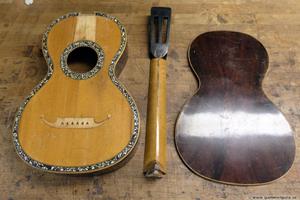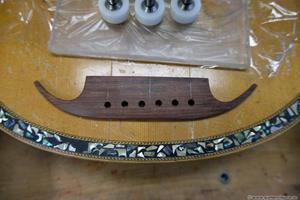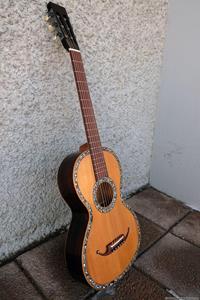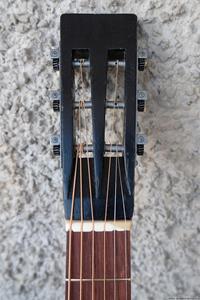One of the more fun guitars in the batch is this one with more *bling* than most people can handle. I've seen several similar ones over the years, but still do not know where or when they were made. Just a few months ago I bought a similar one at a local auction here in Örnsköldsvik, it seems possible to find more of them here in Sweden. I suspect they were made in the 1920s in Europe, probably in Germany.
The sumptuous mother-of-pearl inlays around the top and in the rosette were made to mimic very lavish pearl guitars from the 1800th century, where all inlays were finely sawn and carefully placed. On this, they have instead used waste from a production of mother-of-pearl inserts and put the pieces quick and easily into a black "daub". The mother-of-pearl glitters nicely at dusk, and from a distance it clearly looks impressive! If you look closely, you see that some waste pieces have nice negative details left from the manufacture of mother-of-pearl inserts. The black "daub" is probably made of fish glue or hare glue mixed with lamp black or ebony dust, but I do not know exactly how it was done. Here are some examples of the costly and fine instruments it seeks to emulate.
The guitar thus tries to look nicer than it is! These guitars are usually lightly built (to sound good when they were new) and have a fairly thick V-shaped neck. Instead of painting the maple neck completely black, they have chosen to only paint black on the head, the rest of the neck was given a transparent varnish. Here are some pictures of the guitar from the waiting room before I started working on it.
The guitar was in perfectly OK condition, the only major problem was that the top was really shrunk and had cracked in several places. The neck was also about to slide into the sound hole due to the cracks on both sides of the fretboard. The bottom and side of the maple were vein-painted. By sanding away the paint around the edge of the bottom, you get the illusion that it has a binding in light wood. The decoration on the top is more lavish, with purfling on both sides of the milled pearl ditches. It had a flat fingerboard in rosewood and a black-painted maple mustache bridge, the small decorations at the tips of the mustache were missing. The old tuners were working, but were replaced with new and better ones.
When it joined the batch when the others were already half-finished, it was taken apart and got its ribs and carbon fiber rod quickly without me taking pictures in the meantime. The bottom and lid were already thin and just needed to be thinned out a little grand. Took some pictures when it got its ribs and when the cracks in the lid were filled with spruce from an old scrapped lid.
A new bridge was made of rosewood, the original in maple is a little too soft and too narrow for an intoned saddle. In the picture, the plugs and the round buttons are glued around the string pin holes in the spruce bridge plate. The flat fretboard was replaced with a new rosewood one with a 16 ′ radius.
The customer did not like thick necks, so the V-neck was rounded off on the underside to a more rounded and less thick shape. It went well and with a little varnish on the neck, it looks as good as it feels nice to play on. The maple in the neck turned out to have a beautiful figure as well, it came out after sanding and varnishing. New tuners were fitted and the decorations on the ends of the bridge's mustache were made. A K&K mic was also installed.
I succeeded well with the neck set, fretting and intonation. When it was finished, I did not expect it to sound particularly good, as the large amount of mother-of-pearl around the edge of the top hardly is good for the sound. But it sounded good, just like an GammelGura should. I hope the customer is satisfied. I think it is very charming with it's cheap, but still beautiful, *bling*!




















